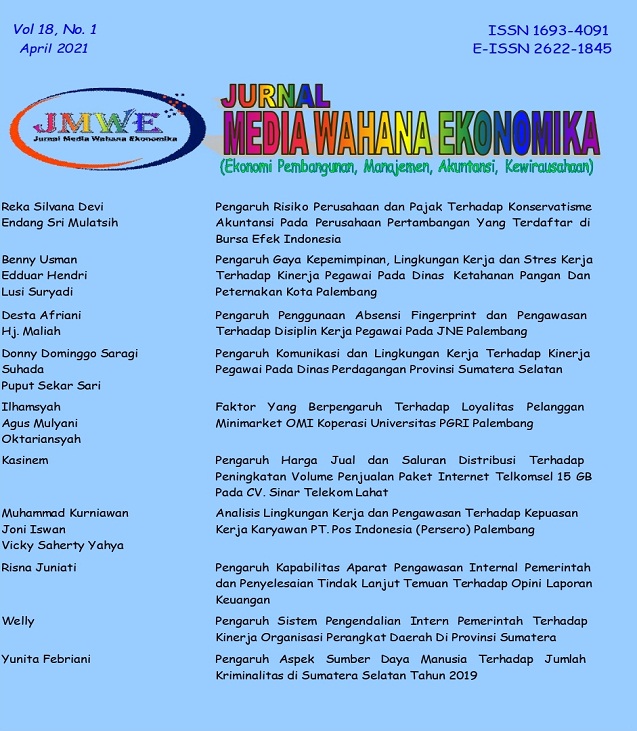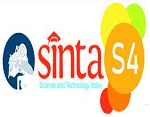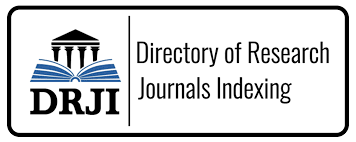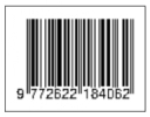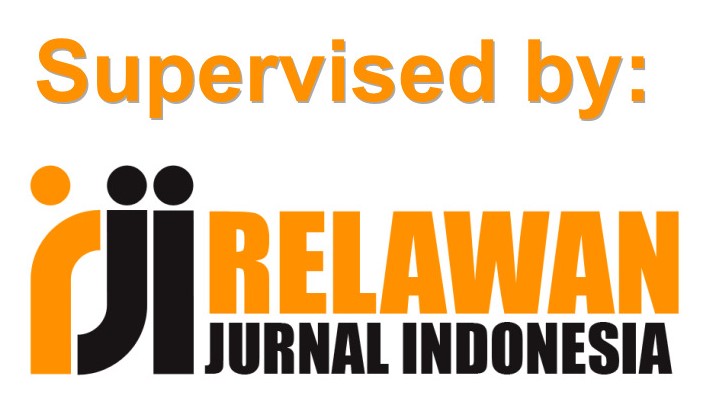Pengaruh Komunikasi dan Lingkungan Kerja Terhadap Kinerja Pegawai Pada Dinas Perdagangan Provinsi Sumatera Selatan
DOI:
https://doi.org/10.31851/jmwe.v18i1.5582Abstract
ABSTRAK
Â
Metode penelitian yang digunakan adalah metode penelitian kuantitatif, dengan populasi seluruh pegawai Kantor Dinas Perdagangan Provinsi Sumatera Selatan berjumlah 69 orang pegawai. Sampel yang digunakan dalam penelitian ini menggunakan teknik sampling jenuh sehingga diperoleh sampel sebanyak 69 pegawai. Teknik pengumpulan data dilakukan dengan observasi dan kuesioner. Teknik analisis data menggunakan analisis regresi linear berganda, koefisien determinasi, pengujian hipotesis uji t dan uji F. Hasil penelitian ini dapat diketahui bahwa nilai persamaan regresi linear berganda Y=16,497+0,443X1+0,583X2+e. Hasil koefisien determinasi menunjukan nilai R Square sebesar 0,508 atau 50,8% artinya kontribusi sumbangan pengaruh Komunikasi (X1) dan Lingkungan Kerja (X2) terhadap Kinerja Pegawai (Y) sebesar 50,8%. Hasil pengujian hipotesis uji t Komunikasi (X1) terhadap Kinerja Pegawai (Y) diperoleh nilai signifikan 0,014 <α signifikan 0,05 maka dapat disimpulkan secara parsial ada pengaruh yang signifikan antara Komunikasi terhadap Kinerja Pegawai pada Dinas Perdagangan Provinsi Sumatera Selatan. Hasil Pengujian hipotesis uji t Lingkungan Kerja (X2) terhadap Kinerja Pegawai (Y) diperoleh nilai signifikan 0,006 <α signifikan 0,05 maka dapat disimpulkan secara parsial ada pengaruh yang signifikan antara Lingkungan Kerja terhadap Kinerja Pegawai pada Dinas Perdagangan Provinsi Sumatera Selatan. Hasil pengujian hipotesis uji F diperoleh nilai signifikan 0,000 <α 0,05 maka hipotesis Ha (Hipotesis alternatif) diterima dan Ho (Hipotesis nol) ditolak, maka dapat disimpulkan bahwa secara bersama-sama ada pengaruh yang signifikan antara Komunikasi dan Lingkungan Kerja terhadap Kinerja Pegawai pada Dinas Perdagangan Provinsi Sumatera Selatan.
Â
Kata Kunci: Komunikasi , Lingkungan Kerja, Kinerja Pegawai
Â
ABSTRACT
Â
The research method used is quantitative research methods, with a population of all 69 employees of the Office of Trade in the Province of South Sumatra. The sample used in this study used a saturated sampling technique in order to obtain a sample of 69 employees. The data collection technique was carried out by observation and questionnaires. The data analysis technique used multiple linear regression analysis, coefficient of determination, hypothesis testing t test and F test. The results of this study can be seen that the value of the multiple linear regression equation Y = 16.497 + 0.443X1 + 0.583X2 + e. The coefficient of determination shows that the value of R Square is 0.508 or 50.8%, which means that the contribution of the influence of Communication (X1) and the Work Environment (X2) on Employee Performance (Y) is 50.8%. The results of testing the t test hypothesis Communication (X1) on Employee Performance (Y) obtained a significant value of 0.014 <α significant 0.05, it can be concluded that partially there is a significant influence between Communication on Employee Performance at the South Sumatra Province Trade Office. The results of the t-test hypothesis testing for the Work Environment (X2) on Employee Performance (Y) obtained a significant value of 0.006 <α significant 0.05, it can be concluded that partially there is a significant influence between the Work Environment on Employee Performance at the South Sumatra Province Trade Office. The results of testing the F test hypothesis obtained a significant value of 0.000 <α 0.05, then the hypothesis Ha (alternative hypothesis) is accepted and Ho (null hypothesis) is rejected, it can be concluded that together there is a significant influence between Communication and Work Environment on Employee Performance. at the Trade Office of South Sumatra Province.
Â
Keywords: Communication, Work Environment, Employee PerformanceReferences
Busro, Muhammad. 2018. Teori-Teori Manajemen Sumber Daya Manusia. Jakarta : Prenada Media Group.
Kurniawan, Albert. 2014. Metode Riset Untuk Ekonomi dan Bisnis. Bandung: Alfabeta.
Mangkunegara, 2015. Manajemen Sumber Daya Perusahaan. Badan Penerbit PT. Remaja Rosdakarya. Bandung
Oktariansyah, 2012. Pengaruh Kepemimpinan Dan Lingkungan Kerja Fisik Terhadap Motivasi Kerja Karyawan CV. Sedulur Palembang. Jurnal Media Wahana Ekonomika Vol. 9, No.2, Juli 2012 : 80 - 93
Priyatno, Duwi. 2016. Paham Analisa Statistik Data dengan SPSS. Yogyakarta: Mediakom Remaja Rosdakarya.
Buku Panduan Muda Olah Data bagi Mahasiswa dan Umum. Bandung Alfabeta.
Prihantoro, 2015. Peningkatan Kinerja Sumber Daya Manusia Melalui Motivasi, Disiplin, Lingkungan Kerja, dan Komitmen. Yogyakarta : CV Budi Utama
Riduwan, 2015. Belajar Mudah Penelitian Untuk Guru-Karyawan dan Peneliti Pemula. Bandung : Alfabeta.
Sastrohadiwiryo, Siswanto. (2009). Manajemen Tenaga Kerja Indonesia Pendekatan Administrasi dan Oprasional, Bumi Aksara, Jakarta.
Sedarmayanti, 2011. Tata Kerja dan Produktivitas Kerja : Suatu Tinjauan Dari Aspek Ergonomi Atau Kaitan Antara Manusia dengan Ligkungan Kejranya. Cetakan Ketiga. Bandung : Mandar Maju.
Siregar. 2017. Statistik Parametrik Untuk Penelitian Kuantitatif. Jakarta: Bumi Aksara.
Sugiyono, 2015.Metodelogi Penelitian Kualitatif & Kuantitatif. Bandung: Alfabeta.
, 2013. Metodelogi Penelitian Bisnis. Bandung: Alfabeta.
Sujarweni, Wiratna. 2015. Metode Penelitian Bisnis dan Ekonomi. Yogyakarta: Pustaka Baru Press.
Sunyoto, Danang. 2015. Penelitian Sumber Daya Manusia. Jakarta : Buku Seru.
Wibowo. 2011. Manajemen Kinerja, Jakarta : Raja Grafindo Persada.
Downloads
Published
Issue
Section
License
The copyright of the received article shall be assigned to the publisher of the journal licensed under a Creative Commons Attribution-NonCommercial 4.0 International License in line with the license, authors and any users (readers and other researchers) are allowed to share and adapt the material only for non-commercial purposes. In addition, the material must be given appropriate credit, provided with a link to the license, and indicated if changes were made. If authors remix, transform or build upon the material, authors must distribute their contributions under the same license as the original.

